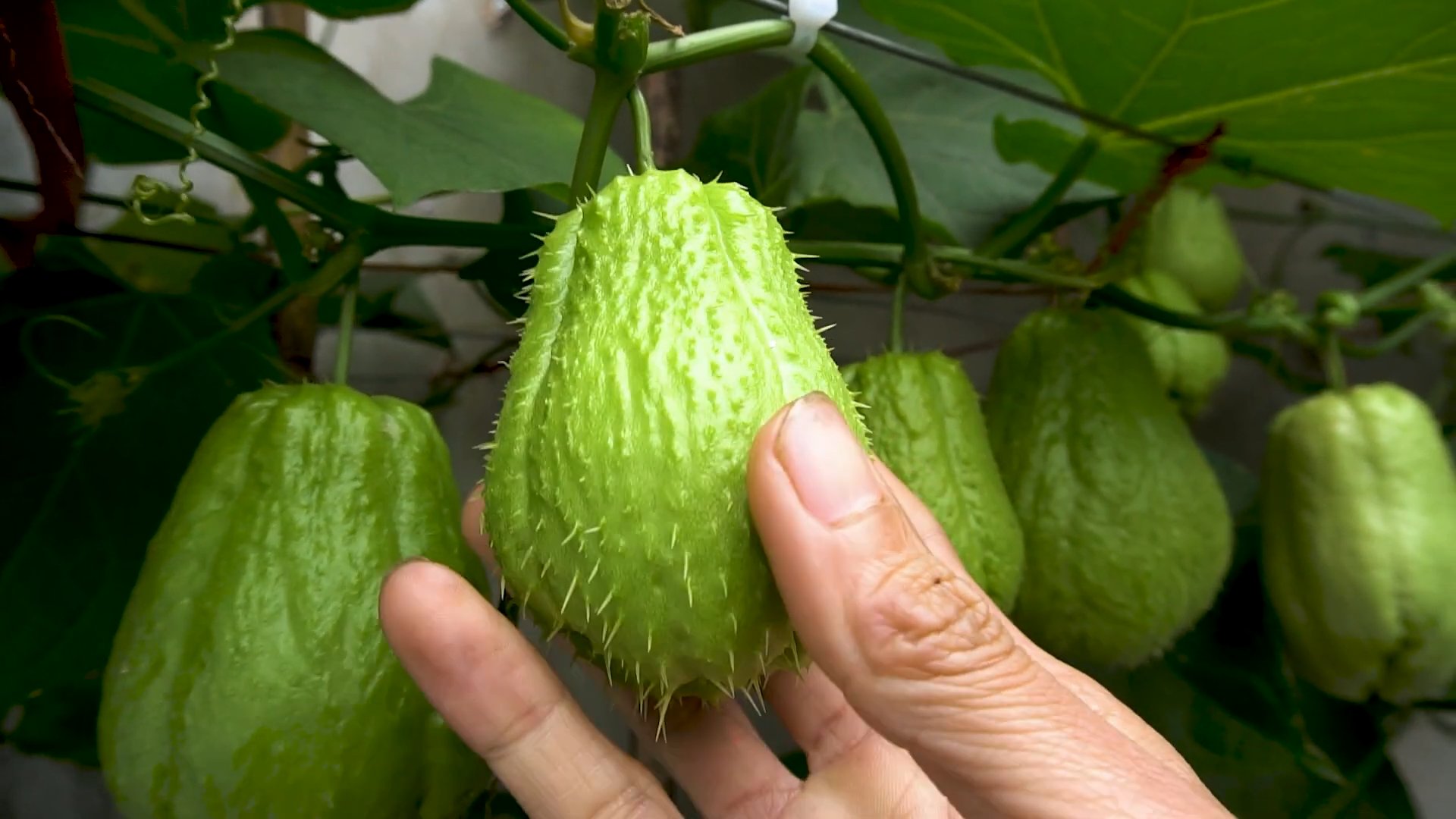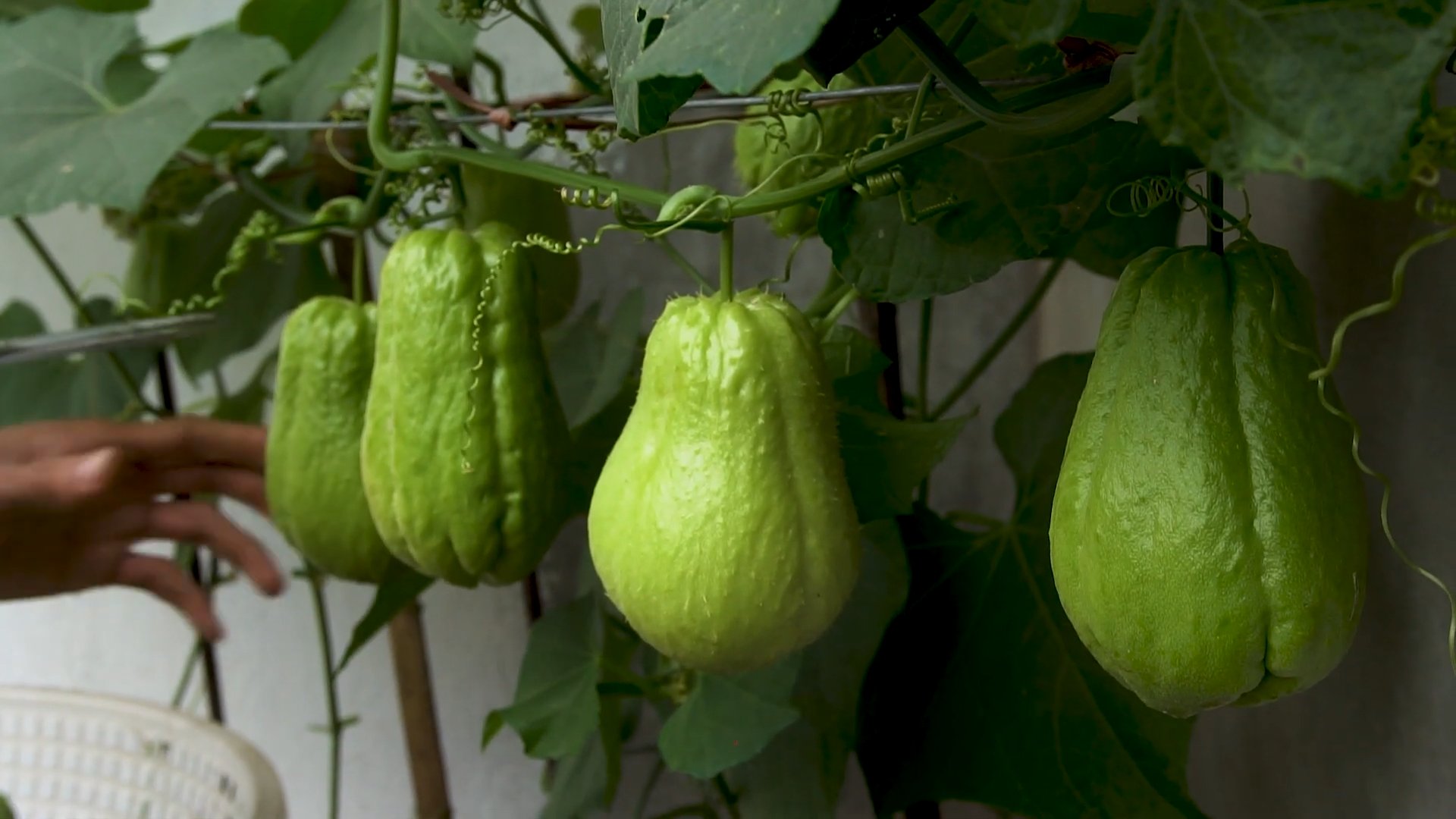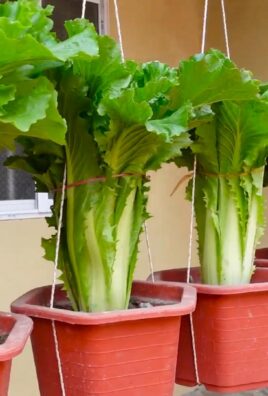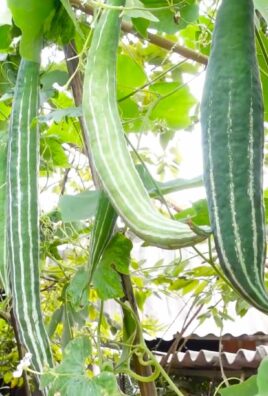Grow Chayote at Home? Absolutely! Imagine stepping into your backyard and harvesting your own fresh, vibrant chayote squash. It’s not just a dream; it’s an achievable reality with a few simple tricks and a little DIY spirit. I’m here to guide you through the process, making it easier than you ever thought possible.
Chayote, also known as vegetable pear or mirliton, has a fascinating history, deeply rooted in Mesoamerican cultures. For centuries, it has been a staple in their diets, prized for its versatility and nutritional benefits. Now, you can bring this piece of culinary history to your own table!
Why should you bother with this DIY project? Well, store-bought chayote can sometimes be bland or lack the freshness you desire. Plus, growing your own allows you to control the growing environment, ensuring you have organic, pesticide-free produce. More importantly, learning how to grow chayote at home is incredibly rewarding. There’s nothing quite like the satisfaction of nurturing a plant from seed (or in this case, the whole fruit!) to harvest. Ready to get your hands dirty? Let’s dive into these easy-to-follow home gardening tricks and unlock the secrets to a bountiful chayote harvest!

Growing Chayote Squash: A Beginner’s Guide to Bountiful Harvests
Hey there, fellow gardening enthusiasts! Have you ever considered growing your own chayote squash? It’s a fantastic, versatile vegetable that’s surprisingly easy to cultivate, even if you’re a beginner like I once was. Trust me, the satisfaction of harvesting your own chayote is truly rewarding. This guide will walk you through every step, from choosing the right chayote to enjoying your homegrown bounty.
Choosing Your Chayote and Preparing for Planting
Before we get our hands dirty, let’s talk about selecting the perfect chayote for planting.
* Choosing the Right Chayote: Look for a mature chayote fruit at your local grocery store or farmer’s market. The key is to find one that has already started to sprout. You’ll notice small roots or a tiny vine emerging from the broader end of the fruit. This is a sign that it’s ready to plant. If you can’t find one already sprouting, don’t worry! You can encourage sprouting by placing the chayote in a paper bag with a few apples for a week or two. The ethylene gas released by the apples will help stimulate sprouting.
* Preparing the Soil: Chayote loves well-drained, fertile soil. Amend your garden soil with plenty of compost or well-rotted manure. This will provide the necessary nutrients and improve drainage. Aim for a slightly acidic to neutral soil pH (around 6.0 to 7.0).
* Choosing the Right Location: Chayote vines are vigorous climbers, so they need plenty of space and a sturdy support structure. A trellis, fence, or even a strong pergola will work perfectly. Make sure the location receives at least 6-8 hours of sunlight per day.
Planting Your Chayote
Now for the fun part! Let’s get that chayote in the ground.
1. Dig a Hole: Dig a hole that’s about twice the size of the chayote fruit. This will give the roots plenty of room to spread out.
2. Position the Chayote: Place the chayote in the hole with the sprouted end (where the roots or vine are emerging) facing upwards. The majority of the fruit should be buried, leaving only the very top exposed.
3. Backfill with Soil: Gently backfill the hole with the amended soil, being careful not to damage the sprout.
4. Water Thoroughly: Water the newly planted chayote thoroughly to settle the soil and provide moisture.
Caring for Your Chayote Vine
Chayote vines are relatively low-maintenance, but they do need some attention to thrive.
* Watering: Water regularly, especially during dry periods. Chayote needs consistent moisture to produce a good harvest. Aim for about an inch of water per week.
* Fertilizing: Feed your chayote vine with a balanced fertilizer every few weeks during the growing season. Look for a fertilizer with a ratio of 10-10-10 or something similar.
* Pruning: Pruning isn’t strictly necessary, but it can help to control the size of the vine and improve air circulation. Remove any dead or damaged leaves and stems. You can also trim back the vine if it becomes too unruly.
* Providing Support: As the vine grows, it will need support to climb. Train the vine to grow up the trellis or fence by gently guiding the tendrils.
Dealing with Pests and Diseases
Chayote is generally resistant to pests and diseases, but it’s still important to be vigilant.
* Common Pests: Aphids, spider mites, and squash bugs can sometimes be a problem. Inspect your vine regularly for signs of infestation. If you find any pests, you can try spraying them with insecticidal soap or neem oil.
* Common Diseases: Powdery mildew can sometimes affect chayote vines, especially in humid conditions. To prevent powdery mildew, ensure good air circulation around the vine and avoid overhead watering. If you see signs of powdery mildew, you can treat it with a fungicide.
Harvesting Your Chayote
The moment we’ve all been waiting for! Harvesting your own chayote is incredibly satisfying.
* When to Harvest: Chayote is typically ready to harvest about 3-4 months after planting. The fruits should be firm and light green in color. They should also be relatively small, about the size of a pear or avocado.
* How to Harvest: Use a sharp knife or pruners to cut the chayote from the vine. Leave a small stem attached to the fruit.
* Storing Your Harvest: Chayote can be stored in the refrigerator for several weeks. Wrap them in a plastic bag to prevent them from drying out.
Enjoying Your Chayote Harvest
Chayote is a versatile vegetable that can be used in a variety of dishes.
* Raw: Chayote can be eaten raw in salads or as a snack. It has a mild, slightly sweet flavor.
* Cooked: Chayote can be boiled, steamed, baked, or stir-fried. It’s often used in soups, stews, and casseroles.
* Pickled: Chayote can also be pickled. Pickled chayote is a popular condiment in many cultures.
Troubleshooting Common Chayote Growing Problems
Even with the best care, you might encounter some challenges. Here are a few common problems and how to address them:
* No Fruit Production: This is perhaps the most frustrating issue. Chayote is a short-day plant, meaning it needs shorter days to initiate flowering and fruiting. If you live in an area with long summers, your vine might not produce fruit until late in the season or even the following year. Be patient! Also, ensure your vine is getting enough sunlight and nutrients. Sometimes, lack of pollination can also be a factor. While chayote is self-fertile, having multiple vines can increase pollination rates.
* Yellowing Leaves: Yellowing leaves can indicate several problems, including overwatering, underwatering, nutrient deficiencies, or pest infestations. Check the soil moisture and adjust your watering schedule accordingly. Fertilize your vine with a balanced fertilizer. Inspect the leaves for signs of pests.
* Slow Growth: Slow growth can be caused by poor soil, lack of sunlight, or cool temperatures. Amend your soil with compost or manure. Ensure your vine is getting at least 6-8 hours of sunlight per day. Chayote prefers warm temperatures, so if you live in a cooler climate, you might need to start your chayote indoors.
* Fruit Rot: Fruit rot can be caused by fungal diseases, especially in humid conditions. Ensure good air circulation around the vine and avoid overhead watering. Remove any infected fruits immediately. You can also treat the vine with a fungicide.
Propagating Chayote from Seeds (Advanced)
While planting the whole fruit is the most common method, you can also try propagating chayote from seeds, although it’s a bit more challenging.
1. Extracting the Seed: Carefully cut open a mature chayote fruit and remove the seed.
2. Germinating the Seed: Wrap the seed in a damp paper towel and place it in a plastic bag. Store the bag in a warm, dark place for several weeks, until the seed sprouts.
3. Planting the Sprouted Seed: Once the seed has sprouted, plant it in a pot filled with well-drained potting mix.
4. Transplanting: Once the seedling has developed several leaves, you can transplant it into your garden.
Chayote Varieties (If you want to get fancy!)
While most people grow the common green chayote, there are actually several varieties available.
* Smooth Green: This is the most common variety, with smooth, light green skin.
* Spiny Green: This variety has small spines on its skin.
* White Chayote: This variety has white skin and a slightly sweeter flavor.
* Black Spine Chayote: This variety has dark green skin with black spines.
Expanding Your Chayote Knowledge
* Companion Planting: Chayote benefits from companion planting. Good companions include beans, corn, and squash. Avoid planting chayote near potatoes or tomatoes.
* Saving Seeds: If you want to save seeds from your chayote, allow a few fruits to mature fully on the vine. Then, harvest the fruits and extract the seeds. Store the seeds in a cool, dry place.
* Chayote Leaves and Shoots: Don’t forget that the leaves and shoots of the chayote vine are also edible! They can be cooked like spinach or added to soups and stews.
Final Thoughts
Growing chayote squash is a rewarding experience that anyone can enjoy. With a little patience and care, you’ll be harvesting your own delicious chayote in no time. So, get out there, get your hands dirty, and start growing! Happy gardening!

Conclusion
So, there you have it! Growing chayote at home is not only achievable, but it’s also a rewarding experience that brings fresh, homegrown produce right to your kitchen. We’ve walked you through the process, from sprouting the fruit to nurturing the vine, and hopefully, you’re now feeling confident and ready to embark on this exciting gardening adventure.
Why is this DIY trick a must-try? Because it offers a unique opportunity to connect with your food source, reduce your reliance on store-bought vegetables, and enjoy the unparalleled flavor of freshly harvested chayote. Imagine the satisfaction of serving a dish made with chayote you nurtured from a single fruit! Plus, chayote vines are incredibly prolific, meaning you’ll likely have more than enough to share with friends and neighbors.
Beyond the basic method we’ve outlined, there’s plenty of room for experimentation and personalization. Consider these variations:
* Vertical Gardening: Chayote vines are natural climbers, so maximize your space by training them on a trellis, fence, or even a sturdy pergola. This not only looks beautiful but also keeps the fruit off the ground, preventing rot and making harvesting easier.
* Container Gardening: While chayote thrives best in the ground, you can successfully grow it in a large container (at least 20 gallons) if you have limited space. Just ensure the container has excellent drainage and provide a strong support structure for the vine.
* Companion Planting: Enhance your chayote’s growth by planting beneficial companion plants nearby. Marigolds can deter pests, while legumes like beans and peas can fix nitrogen in the soil, providing a natural fertilizer.
* Different Varieties: While the most common chayote is pear-shaped and light green, there are other varieties available, including those with darker green skin or even spiky exteriors. Experiment with different varieties to find your favorite!
Growing chayote at home is a sustainable and fulfilling way to add fresh, nutritious food to your diet. It’s a project that connects you with nature, teaches you about the growing cycle, and provides a delicious reward for your efforts. Don’t be intimidated by the process – it’s simpler than you might think!
We wholeheartedly encourage you to give this DIY trick a try. Start with a single chayote fruit, follow our guide, and watch as it transforms into a thriving vine laden with delicious produce. And most importantly, share your experience with us! We’d love to hear about your successes, challenges, and any unique tips you discover along the way. Post photos of your chayote vines, share your favorite chayote recipes, and let’s build a community of chayote enthusiasts! Happy gardening!
Frequently Asked Questions (FAQ)
What is the best time of year to start growing chayote?
The best time to start sprouting your chayote fruit is in late winter or early spring, about 6-8 weeks before the last expected frost. This gives the seedling a head start before transplanting it outdoors once the weather warms up. If you live in a frost-free climate, you can start the process at any time of year. However, keep in mind that chayote is a warm-season crop and will thrive best during the warmer months.
How long does it take for a chayote fruit to sprout?
Sprouting time can vary depending on the temperature and humidity levels, but generally, it takes anywhere from 2 to 4 weeks for the chayote fruit to sprout. Be patient and ensure the fruit remains consistently moist but not waterlogged. You’ll know it’s sprouting when you see a small shoot emerging from the broader end of the fruit.
What kind of soil is best for growing chayote?
Chayote thrives in well-draining, fertile soil that is rich in organic matter. A loamy soil is ideal. Before planting, amend your soil with compost, aged manure, or other organic materials to improve its drainage and nutrient content. A slightly acidic to neutral soil pH (around 6.0 to 7.0) is also preferred.
How much sunlight does chayote need?
Chayote vines need at least 6-8 hours of direct sunlight per day to thrive and produce abundant fruit. Choose a planting location that receives plenty of sunlight throughout the day. If you live in a particularly hot climate, some afternoon shade can be beneficial to prevent the leaves from scorching.
How often should I water my chayote vine?
Water your chayote vine regularly, especially during hot and dry periods. Aim to keep the soil consistently moist but not waterlogged. Water deeply at the base of the plant, avoiding wetting the foliage, which can increase the risk of fungal diseases. A good rule of thumb is to water when the top inch of soil feels dry to the touch.
Does chayote need fertilizer?
Yes, chayote vines benefit from regular fertilization, especially during the growing season. Use a balanced fertilizer (e.g., 10-10-10) or a fertilizer specifically formulated for vegetables. Apply the fertilizer according to the package instructions, typically every 4-6 weeks. You can also supplement with organic fertilizers like compost tea or fish emulsion.
How do I control pests and diseases on my chayote vine?
Chayote vines are generally resistant to pests and diseases, but they can occasionally be affected by aphids, spider mites, or powdery mildew. To prevent these problems, ensure good air circulation around the vine, avoid overwatering, and inspect the plant regularly for any signs of infestation or disease. If you spot pests, you can try spraying them with insecticidal soap or neem oil. For powdery mildew, use a fungicide specifically designed for this disease.
When can I harvest chayote fruit?
Chayote fruit is typically ready to harvest about 3-4 months after planting. The fruit should be firm and smooth, with a light green color. You can harvest the fruit when it’s still relatively small (about the size of a pear) or allow it to grow larger. The larger the fruit, the more mature it will be, and the tougher the skin may become. Harvest the fruit by cutting it from the vine with a sharp knife or pruning shears.
Can I eat the entire chayote plant?
Yes, almost all parts of the chayote plant are edible! The fruit is the most commonly consumed part, but the leaves, shoots, roots (tubers), and seeds are also edible. The leaves and shoots can be cooked like spinach, the roots can be boiled or roasted like potatoes, and the seeds can be eaten raw or roasted.
How do I store chayote fruit?
Chayote fruit can be stored in the refrigerator for several weeks. Wrap the fruit in a plastic bag or store it in a crisper drawer to prevent it from drying out. You can also freeze chayote fruit for longer storage. To freeze, peel and dice the fruit, blanch it in boiling water for a few minutes, and then freeze it in airtight containers or freezer bags.





Leave a Comment